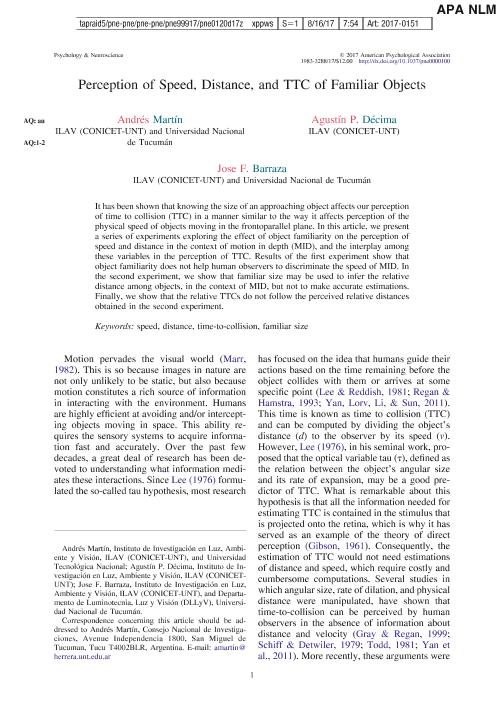Mostrar el registro sencillo del ítem
dc.contributor.author
Martín, Andrés

dc.contributor.author
Decima, Agustin Patricio Rafael

dc.contributor.author
Barraza, Jose Fernando

dc.date.available
2018-11-26T19:33:50Z
dc.date.issued
2017-09
dc.identifier.citation
Martín, Andrés; Decima, Agustin Patricio Rafael; Barraza, Jose Fernando; Perception of speed, distance, and TTC of familiar objects; American Psychological Association Inc.; Psychology and Neuroscience; 10; 3; 9-2017; 261-272
dc.identifier.issn
1983-3288
dc.identifier.uri
http://hdl.handle.net/11336/65213
dc.description.abstract
It has been shown that knowing the size of an approaching object affects our perception of time to collision (TTC) in a manner similar to the way it affects perception of the physical speed of objects moving in the frontoparallel plane. In this article, we present a series of experiments exploring the effect of object familiarity on the perception of speed and distance in the context of motion in depth (MID), and the interplay among these variables in the perception of TTC. Results of the first experiment show that object familiarity does not help human observers to discriminate the speed of MID. In the second experiment, we show that familiar size may be used to infer the relative distance among objects, in the context of MID, but not to make accurate estimations. Finally, we show that the relative TTCs do not follow the perceived relative distances obtained in the second experiment.
dc.format
application/pdf
dc.language.iso
eng
dc.publisher
American Psychological Association Inc.
dc.rights
info:eu-repo/semantics/openAccess
dc.rights.uri
https://creativecommons.org/licenses/by-nc-sa/2.5/ar/
dc.subject
Distance
dc.subject
Familiar Size
dc.subject
Speed
dc.subject
Time-To-Collision
dc.subject.classification
Psicología

dc.subject.classification
Psicología

dc.subject.classification
CIENCIAS SOCIALES

dc.title
Perception of speed, distance, and TTC of familiar objects
dc.type
info:eu-repo/semantics/article
dc.type
info:ar-repo/semantics/artículo
dc.type
info:eu-repo/semantics/publishedVersion
dc.date.updated
2018-11-12T13:25:19Z
dc.journal.volume
10
dc.journal.number
3
dc.journal.pagination
261-272
dc.journal.pais
Estados Unidos

dc.journal.ciudad
Washington
dc.description.fil
Fil: Martín, Andrés. Consejo Nacional de Investigaciones Científicas y Técnicas. Centro Científico Tecnológico Conicet - Tucumán. Instituto de Investigación en Luz, Ambiente y Visión. Universidad Nacional de Tucumán. Facultad de Ciencias Exactas y Tecnología. Instituto de Investigación en Luz, Ambiente y Visión; Argentina
dc.description.fil
Fil: Decima, Agustin Patricio Rafael. Consejo Nacional de Investigaciones Científicas y Técnicas. Centro Científico Tecnológico Conicet - Tucumán. Instituto de Investigación en Luz, Ambiente y Visión. Universidad Nacional de Tucumán. Facultad de Ciencias Exactas y Tecnología. Instituto de Investigación en Luz, Ambiente y Visión; Argentina
dc.description.fil
Fil: Barraza, Jose Fernando. Consejo Nacional de Investigaciones Científicas y Técnicas. Centro Científico Tecnológico Conicet - Tucumán. Instituto de Investigación en Luz, Ambiente y Visión. Universidad Nacional de Tucumán. Facultad de Ciencias Exactas y Tecnología. Instituto de Investigación en Luz, Ambiente y Visión; Argentina
dc.journal.title
Psychology and Neuroscience
dc.relation.alternativeid
info:eu-repo/semantics/altIdentifier/url/http://psycnet.apa.org/record/2017-44275-001
dc.relation.alternativeid
info:eu-repo/semantics/altIdentifier/doi/https://dx.doi.org/10.1037/pne0000100
dc.relation.alternativeid
info:eu-repo/semantics/altIdentifier/url/http://psycnet.apa.org/doiLanding?doi=10.1037%2Fpne0000100
Archivos asociados
